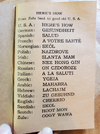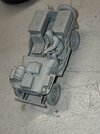Pretty intense topic with a lot of brain power invested, deep thought, from all different points, excellent perceptions. This has been an excellent read, Gents, very informative!
Something that I have not seen mentioned, unless I blew past it, which I hope I didn't, is a concept that I have personally adopted and have been using for a very long time now, and that is this; build and paint for the camera. This is not my original idea, not a chance, but from one of the best figure painters I have ever had the privilege to meet, as well as an armor builder who publishes his own book series. Both were basically saying the same thing, build and paint for the camera.
Let me see if I can explain this concept better than, "clear as mud", so here goes. Jakko, please feel free to correct me, if needs be. HA!




I've said it before, several times, I am playing to the camera, nothing more. None of you will ever be standing anywhere near any of my builds unless you were right here in my presence, or see them at a competition. My work is only seen on-line, so I have to build and paint accordingly, for the camera.
When I plan a dio, scene, or scenario, I do so with the camera in mind, specifically. I always paint my figures, rigs, and structures "for the camera." Just like a combat correspondent taking live shots of the action, or battle scene, I attempt to put the viewer right there, as if physically present. I don't calculate the distances, mathematics, or any other concept, just how the camera views the subject. I can't say I've always been successful at this, but sometimes I do get decent results. It's a constant learning process for me.
So, if you see heavy panel lines or weathering that appears excessive, it should be what a viewer would actually see if he was looking at it in person, with that object right in front of him, where he could reach out and touch it, if he chose to do so. Whatever distance the lens has been used to represent the scene is how the subject should be painted, heavy weathered, panel lines, or not. This is how I personally work.
This leads into another topic that is an art form in and of itself, taking decent photos of our work. It's taken me some time to learn how this all works, and I'm not, by any stretch, a top dog pic taker, just average. I would like to think my pics get the point across as to what I have intended the viewer to see. Like I said, I'm still learning.
Most of us have been "sniffin paint and gluin our fingers together" long enough to recognize an overdone rig or figure. It smacks us in the face quickly, intensely, and can be a put off,………then we say,……..next. And then again, we've all seen the subtle weathering and brush work that looks natural, more realistic, and pleasing to the eyes. However you want to phrase it, it is personal perception and everyone is different, natrually.
So, long story short, I build and paint for the camera and whatever that may call for. I strive to accomplish this in a realistic manner, if possible. That's all I can personally do, try, and then keep trying.
Great subject Gents, Ruck On! Cheers, Ski.


